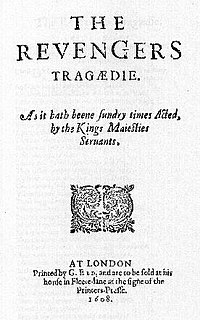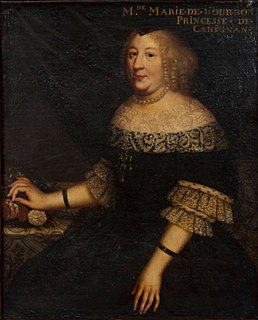
George Chapman was an English dramatist, translator and poet. He was a classical scholar whose work shows the influence of Stoicism. Chapman has been speculated to be the Rival Poet of Shakespeare's sonnets by William Minto, and as an anticipator of the metaphysical poets of the 17th century. Chapman is best remembered for his translations of Homer's Iliad and Odyssey, and the Homeric Batrachomyomachia.

Eastward Hoe or Eastward Ho! is an early Jacobean-era stage play written by George Chapman, Ben Jonson and John Marston. The play was first performed at the Blackfriars Theatre by a company of boy actors known as the Children of the Queen's Revels in early August 1605, and it was printed in September the same year.

The Revenger's Tragedy is an English-language Jacobean revenge tragedy which was performed in 1606, and published in 1607 by George Eld. It was long attributed to Cyril Tourneur, but "The consensus candidate for authorship of The Revenger’s Tragedy at present is Thomas Middleton, although this is a knotty issue that is far from settled."

Parasitaster, or The Fawn is an early Jacobean play, written by the dramatist and satirist John Marston, probably in 1604, and performed by the Children of the Queen's Revels in the Blackfriars Theatre.
The Isle of Gulls is a Jacobean era stage play written by John Day, a comedy that caused a scandal upon its premiere in 1606.

William Larkin was an English painter active from 1609 until his death in 1619, known for his iconic portraits of members of the court of James I of England which capture in brilliant detail the opulent layering of textiles, embroidery, lace, and jewellery characteristic of fashion in the Jacobean era, as well as representing numerous fine examples of oriental carpets in Renaissance painting.
The Duke of Milan is a Jacobean era stage play, a tragedy written by Philip Massinger. First published in 1623, the play is generally considered among the author's finest achievements in drama.
The Tragedy of Bussy D'Ambois (1603–1607) is a Jacobean stage play written by George Chapman. Classified as either a tragedy or "contemporary history," Bussy D'Ambois is widely considered Chapman's greatest play, and is the earliest in a series of plays that Chapman wrote about the French political scene in his era, including the sequel The Revenge of Bussy D'Ambois, the two-part The Conspiracy and Tragedy of Charles, Duke of Byron, and The Tragedy of Chabot, Admiral of France.
The Conspiracy and Tragedy of Charles, Duke of Byron, Marshall of France is a Jacobean tragedy by George Chapman, a two-part play or double play first performed and published in 1608. It tells the story of Charles de Gontaut, duc de Biron, executed for treason in 1602.
The Revenge of Bussy D'Ambois is a Jacobean revenge tragedy written by George Chapman. The Revenge is a sequel to his earlier Bussy D'Ambois, and was first published in 1613.

Lucy Russell, Countess of Bedford (1580–1627) was a major aristocratic patron of the arts and literature in the Elizabethan and Jacobean eras, the primary non-royal performer in contemporary court masques, a letter-writer, and a poet. She was an adventurer (shareholder) in the Somers Isles Company, investing in Bermuda, where Harrington Sound is named after her.
The Opportunity is a Caroline era stage play, a comedy written by James Shirley, published in 1640. The play has been called "a capital little comedy, fairly bubbling over with clever situations, and charming character."
The Humorous Courtier, also called The Duke, is a Caroline era stage play, a comedy written by James Shirley, first published in 1640.
The Great Duke of Florence is an early Caroline era stage play, a tragicomedy written by Philip Massinger, and first published in 1636. It has been called "one of Massinger's best dramas," and "a masterpiece of dramatic construction."
The Woman Hater, or, The Hungry Courtier is an early Jacobean era stage play, a comedy by Francis Beaumont and John Fletcher. One of the earliest of their collaborations, it was the first of their plays to appear in print, in 1607.
The Noble Gentleman is a Jacobean era stage play, a comedy in the canon of John Fletcher and his collaborators that was first published in the first Beaumont and Fletcher folio of 1647. It is one of the plays in Fletcher's canon that presents significant uncertainties about its date and authorship.
George Eld was a London printer of the Jacobean era, who produced important works of English Renaissance drama and literature, including key texts by William Shakespeare, Ben Jonson, Christopher Marlowe, and Thomas Middleton.

The Gentleman Usher is an early 17th-century stage play, a comedy written by George Chapman that was first published in 1606.

Marie de Bourbon was the wife of Thomas Francis, Prince of Carignano, and thus a princess of Savoy by marriage. At the death of her brother in 1641, she became Countess of Soissons in her own right, passing the title down three generations of the House of Savoy.

Antoine Lefèvre de la Boderie (1555-1615) was a French diplomat and ambassador to England.









